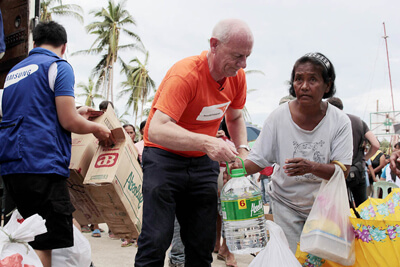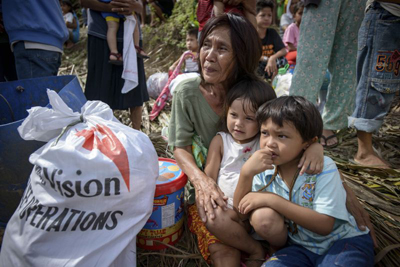
In an article first published in The Age newspaper, TIM COSTELLO, chief executive of World Vision Australia, writes about the situation in The Philippines in the wake of Typhoon Haiyan…
Typhoon Haiyan was more than a typhoon. In Tacloban, it was also a tsunami. Collecting so much water as it hurtled towards land, Haiyan formed an eight metre wall of water, smashing the city flat, drowning people even as they sheltered in their homes.
Typhoons typically cause more injuries than deaths and tsunamis more deaths than injuries. Tacloban, whose city and surrounds until last week was home to more than 1.2 million people, has been struck by a double whammy.
As I flew into Tacloban on a RAAF Hercules C-130 last week, the scene of sheer destruction made me feel like I was back in Aceh in 2004, when I first witnessed the utter devastation that a tsunami can cause.
|
|
|
DELIVERING AID: (top) World Vision CEO Tim Costello helping to distribute food, water and hygiene kits last week; and (below), a Filipino family. PICTURES: Lay Htoo, Jon Warren/World Vision “People had waited six days for help to arrive. Hundreds of children stood by the roadsides with signs reading: ”I am hungry – help me’.” |
Thankfully the death toll in the Philippines looks set to be far less, but the scale of the physical devastation remains hauntingly familiar.
Many wonder, do we ever learn from previous disasters and, if so, why was the initial emergency response so slow this time? I share the frustration.
Perhaps the first explanation is that lessons can be learnt, only to discover they have to be applied in a totally different context.
The host nation is responsible for security. No-one can deliver aid if there is absolute chaos. Geography was also against us in a nation that is an archipelago of 7000 islands.
Last Thursday, I took part in one of the first distributions of food, water and hygiene packs for 4000 people in Tubugon at the northern tip of Cebu.
People had waited six days for help to arrive. Hundreds of children stood by the roadsides with signs reading: ”I am hungry – help me”. But we were handing out just two weeks’ food supply for an initial 780 families. World Vision Australia hopes eventually to assist 10,000 families.
It was orderly, but with people desperate with hunger it felt like a tinderbox. Any misjudgment of numbers could have set off a panic that some would miss out. Thankfully we had done our preparation, carefully identifying and registering families in advance.
In Tacloban, where law and order has broken down, these tinderbox conditions still exist. Unburied bodies still languish in the rubble as the living become more desperate to survive. No one can distribute aid without security because relief workers become the target of people who have nothing to lose.
Late last week, I spoke to the Filipino military commander in charge of the operation in Tacloban, requesting security for World Vision Australia to set up distribution points in and beyond the city. He had been a World Vision supporter during his time as a student in Australia, and we received a sympathetic hearing. Flying aid into Tacloban is now in full swing. Distributing it to far-flung areas yet to be reached is now the urgent challenge.
Australia can be proud of our efforts. The provision of a Hercules C-130 working around the clock bringing in supplies, the empty planes taking the sick or young out, has made a significant difference to the lives of thousands. Some of the first to get out of the apocalyptic Tacloban were those transported by the RAAF.
But so often in an emergency, after the first rush to rescue and provide relief has run its course, the world’s attention and resources switch to the next tragedy, and the recovery effort languishes. Our brains are wired in fright-and-flight, to be touched by a tragedy but not necessarily for the sustained effort and compassion required to get communities back on their feet.
The typhoon’s 40 kilometre radius meant Haiyan had a reach well beyond coastal areas, which is the case in a tsunami. The United Nations has estimated a recovery bill of $US301 million ($321 million).
It is not just the houses that have been mown down but the coconut trees and banana plantations – the livelihoods of whole communities – that have been destroyed, leaving people utterly dependent.
The key in the days and weeks and months ahead will be for the emergency workers to make way for the development specialists who can deliver the practical materials for rebuilding and who know how to help communities as they make the decisions that will enable them to start rebuilding their lives.
One of the strongest lessons of the Aceh recovery was that empowering people to make decisions for themselves is the best therapy for the trauma and loss they’ve suffered.
Despite the short attention span of the world’s interest, we need now to stay the distance.
Tim Costello is the chief executive officer of World Vision Australia. He was in the Philippines last week.This article was first published in The Age newspaper.
To donate to the Emergency Preparedness Fund call 13 32 40 or go to www.worldvision.com.au.






